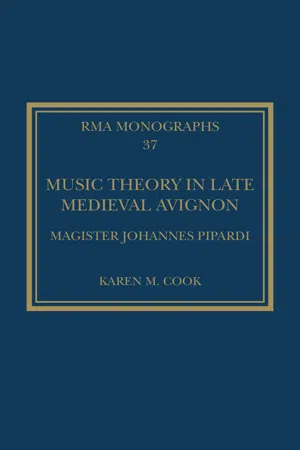![]()
1 The Seville Manuscript
In 1927, Higini Anglès published an overview of extant medieval music manuscripts in his native Spain.1 Included in his list was a composite manuscript that he described as containing around thirty fourteenth- and fifteenth-century theoretical treatises in various stages of completion, most if not all of which were Italian in origin. These treatises were collected during the sixteenth-century travels of Hernando Colón (1488–1539), son of Cristóbal Colón. A well-known scholar, Colón accumulated a massive library housed in Seville, which would eventually include his famous father’s collections after his death in 1506.
Colón’s desire was to have his library maintained and expanded in perpetuity, but its ownership was contested after his own death in 1539. After years of dispute, the library, along with Colón’s detailed catalog of its contents, was finally donated in 1552 to the Cathedral of Seville. Despite the library’s vast reduction in size—the donated materials were well under half of Colón’s original collection—these theoretical treatises were among those preserved in the new Biblioteca Colombina. While Colón’s catalog contained intricate details about the contents, provenance, and purchasing price of each of his library’s items, the treatises comprising this manuscript unfortunately do not appear to have been documented.2 They were only bound together in their present form by librarian Juan de Loiasa in the later seventeenth century. Today the composite manuscript, consisting of 138 parchment and paper folios and still bound in de Loiasa’s original parchment covers, bears the shelf mark 5-2-25.3
Since Anglès’s initial publication, the significance of the manuscript as a primary witness to late medieval music and theory has been widely recognized. In a later publication highlighting the musical sources preserved in the Biblioteca Colombina, Anglès referred to it again as a “precious collection of musical theory of the Middle Ages.”4 He also clarified his original assessment of the manuscript’s contents: it now comprised approximately thirty-one treatises, many fragmentary, some of which originated as early as the thirteenth century. Anglès isolated three brief contiguous works on folios 99–108v as being of particular interest: a treatise he calls De arte cantus, a treatise containing some rules of counterpoint, and a shorter, less formal work written in a mix of Latin and Catalan in the same hand as the previous two works.5 The first two treatises, he noted, were authored by the otherwise unknown theorist “Johannes Pipudi, canonicus Sancti Desiderii Avionensis [sic].”
Several decades later, F. Alberto Gallo revisited Anglès’s work on Sev, narrowing the dates of the manuscript’s contents once more to the mid-fourteenth and fifteenth centuries, and expanding the list of treatises from thirty-one to forty-seven.6 In an accompanying index, he also identified nine musical works, some of which are fragmentary as well. Gallo divided the treatises into three broad categories. The first and largest of these deals primarily with musica plana, and several treatises in this category draw on the Lucidarium by Marchetto of Padua or the Introductio musice by Johannes de Garlandia.7 The second group, again largely anonymous, treats the basics of organum, discantus, and contrapunctus. The last group considers mensural music and includes the treatise Omni desideranti notitiam, three different versions of the Tractatus figurarum, and no fewer than six different witnesses to the treatise commonly known as the Libellus cantus mensurabilis, often attributed to Jean des Murs.8 Among them, Gallo included Pipudi’s De arte cantus, which he labeled in his inventory by its incipit as item XXXV: “[P]ro introducione cognicionis habende de valloribus notularum.”
Gallo’s revised approach to Sev laid the groundwork for many later studies focused on the larger or attributed works. Giuliano Di Bacco’s investigation of the Tractatus figurarum, for example, led him to provisionally revise the manuscript’s inventory, and he identifies thirteen distinct units based on codicological and paleographical evidence (see Table 1).9 Michael Scott Cuthbert clarified this inventory even further in a study of the musical compositions interspersed throughout the manuscript.10 The smaller, fragmentary, anonymous theoretical works that comprise the bulk of Sev, however, have received much less attention.11
Anglès and Gallo both singled out the fascicle comprising folios 99–108v as significant.12 Because ...
